www.aussiebee.com.au
|
|||
| - |
|||
| There are over 1,500 species of "true blue" Australian native bees (see photos of some common examples below). | |||
| - |
|||
| Commercial honey bees (Apis mellifera) are not native to Australia. They were introduced from Europe in about 1822. | |||
| - |
|||
| Australian
native bees can be black, yellow, red, metallic green or even black
with blue polka dots! They can be fat and furry, or sleek and shiny. |
|||
| - |
|||
| Australia's smallest native bee is Cape York's minute Quasihesma bee. It is less than 2 mm long. |
|||
| - |
|||
| Australia's largest native bee is the Great Carpenter Bee of the tropical north and northern NSW. It is up to 24 mm long. | |||
| - |
|||
| Most Australian bees are solitary bees which raise their young in burrows in the ground or in tiny hollows in timber. | |||
| - |
|||
| Australia also has 10 species of social native bees (genera Tetragonula* and Austroplebeia) which do not sting! (Previously called Trigona - Why has their name been changed?) |
|||
| - |
|||
| Stingless bee honey is a delicious bush food and stingless bees can be good crop pollinators. So stingless beekeeping is becoming increasingly popular. | |||
| - |
|||
| Native bees are also important pollinators of Australia's unique wildflowers and are a vital part of our Australian bushland. | |||
| - | |||
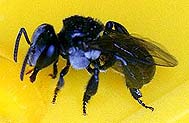 Stingless Social Bee (Tetragonula - previously called Trigona) - 4mm
Stingless Social Bee (Tetragonula - previously called Trigona) - 4mm |
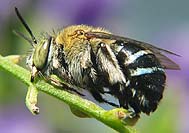 Blue Banded Bee (Amegilla) - 11mm
Blue Banded Bee (Amegilla) - 11mm |
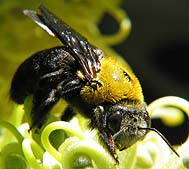 Great Carpenter Bee (Xylocopa) - 24mm
Great Carpenter Bee (Xylocopa) - 24mm |
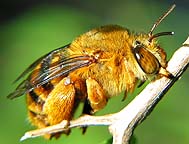 Teddy Bear Bee (Amegilla) - 12mm
Teddy Bear Bee (Amegilla) - 12mm |
| - | |
Introduced European Bees
|
|
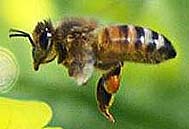 European honeybee (Apis) -- 12mm
European honeybee (Apis) -- 12mmPhoto by Simon Boyd This bee is used for honey production and crop pollination throughout Australia. Feral nests of this bee are also found in most areas of Australia. |
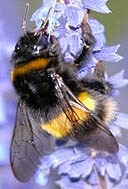 European Bumblebee (Bombus) -- 8 - 22 mm
European Bumblebee (Bombus) -- 8 - 22 mmPhoto by Brian Faulkner A feral population of this bee has become established in Tasmania but fortunately it has not spread to the Australian mainland. More details. |
No comments:
Post a Comment